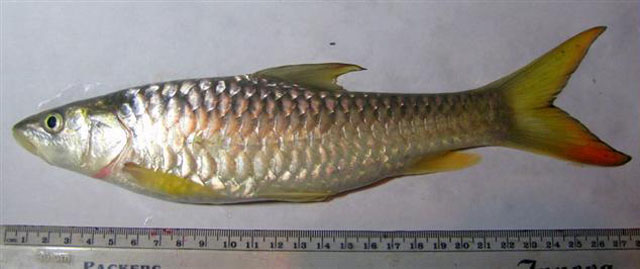| Cyprinidae (Minnows or carps), subfamily: Torinae |
| 275 cm TL (male/unsexed); max.weight: 54 kg |
|
benthopelagic; freshwater; pH range: 7.4 - 8; depth range - 0 m, potamodromous |
| Asia: Afghanistan, Pakistan, India, Nepal, Bangladesh (Ref. 4832), Bhutan (Ref. 9418) and Mynmar (Ref. 57739). |
|
Dorsal spines (total): 4-4; Dorsal soft rays (total): 8-8; Anal spines: 2-2; Anal soft rays: 5-5 |
| Inhabit streams, riverine pools and lakes. Found in rapid streams with rocky bottom (Ref. 41236). Omnivorous, feeding on fish, zooplankton, dipteran larvae and plant matter (Ref. 40948). Juveniles subsist on plankton while fingerlings feed mainly on algae (Ref. 40948). Ascend streams to breed over gravel and stones and returns to perennial ponds after breeding. The most common Himalayan mahseer and a very attractive sport fish, with excellent food value. Specimens over 30 cm and 5 kg in weight are rarely caught in recent times (Ref. 41236). Threatened due to over harvesting and habitat loss (Ref. 58490). |
|
Endangered (EN); Date assessed: 05 August 2018 (A2abcd) Ref. (130435)
|
| harmless |
|
Source and more info: www.fishbase.org. For personal, classroom, and other internal use only. Not for publication.

